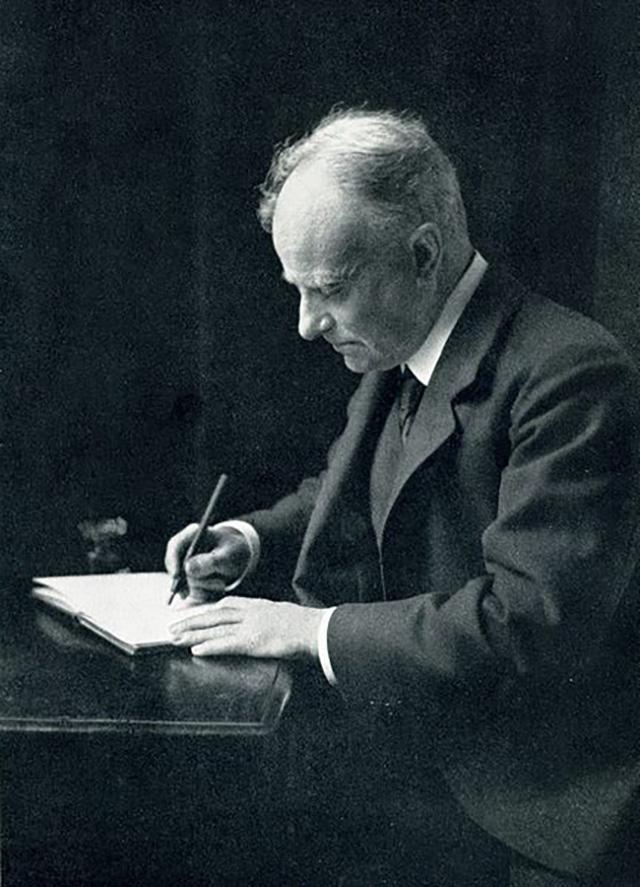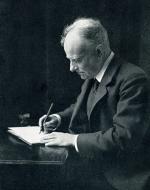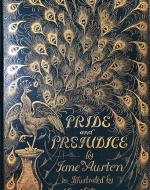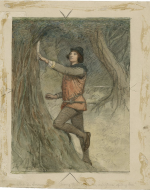Created by Kit Simpson on Sun, 03/17/2024 - 20:46
Description:
Hugh Thomson was born in Corelaine, Ireland, on June 1st, 1860. He had little no training as an artist, and his family originally intended for him to be a clerical worker, even placing him under an apprenticeship at Gibbon and Son, a linen manufacturer. However, Thomson was not pleased with this job, and he took up another job at a print company called Marcus Ward and Co at the age of sixteen. He later moved to London, where he became an illustrator for English Illustration Magazine, where he rose in popularity. Eventually, he was comissioned to illustrate a variety of novels, before eventually being comissioned to illustrate an edition of Jane Austen's Pride and Prejudice (1813). His edition of Pride and Prejudice is undoubtedly his most known work, but Thomson also illustrated for all of Austen's other novels, as well as a multitude of other authors, including J.M Barrie and William Shakespeare. Thomson, notably, did not often work directly alongside authors, but rather was comissioned to illustrate editions of already well-known novels. This exhibition will explore Thomson's notirety as an illustrator, particuarly of lighter and more romantic works of the Early Modern and Regency era, focusing on three of his most popular illustrated editions: Pride and Prejudice (1813), Emma (1816), and Sense and Sensibility (1811), all by Jane Austen, and As You Like It (1599) by William Shakespeare.
Thomson Working at His Desk in 1912," 1912, Artist Unknown, from M. H. Spielmann, Hugh Thomson, His Art, His Letters, His Humour and His Charm, 1931, Wikipedia. Hugh Thomson (1860-1920) is a pen-and-ink illustrator born in Coleraine near Derry in Ireland. Thomson is perhaps best known for his illustrations for Jane Austen’s Pride and Prejudice (1813), which is one of the most collectible books of all time. Thomson also illustrated editions of works by other famous authors, such as William Shakespeare, Charles Dickens, and J.M Barrie. He died on May 7th, 1920, in London.
Hugh Thomson, Cover of Peacock Edition of Pride and Prejudice, 1894, Jane Austen House. Hugh Thomson's most-known work is arguably his cover of Pride and Prejudice, Jane Austen's most-known work. Thomson's edition, first published by George Allen in 1894, features some of the most widely recognizable illustrations of Austen's text. This was the first edition of Pride and Prejudice to fully integrate images into the text. Thomson's cover is identifable due in part to the the gorgeous decorative peacock on the cover, meant to represent Mr. Darcy's proud nature in the novel, as peacocks are notoriously prideful creatures. Through simply the cover of the novel, Thomson is able to subtly foreshadow the romantic story of the prideful Mr. Darcy and prejudiced Elizabeth Bennet. This particular edition would have likely belonged to a higher-class family, as is showcased by the gilded cover. Today, Thomson's Pride and Prejudice is a hot commodity; there are even editions of Pride and Prejudice with Thomson's classic cover, called Peacock Editions, that sell for 13,000 dollars!
Hugh Thomson, "John tells Elinor How Much He hopes Marianne Will Marry Colonel Brandon,"1896, Sense and Sensibility, by Jane Austen, Bridgeman Images. After the success of Thomson's edition of Pride and Prejudice, he later did illustrations for all of Austen's novels. He completed Emma and Sense and Sensibility in 1896, Mansfield Park in 1897, and Northanger Abbey and Persuasion in 1898. While none of Thomson's other illustrated books have reached the level of acclaim that Thomson's Pride and Prejudice did, they are still sold in stores today, showcasing his popularity in the modern era. This illustration is from a scene in Sense and Sensibility, one of the earlier of Thomson's editions, showcasing a conversation between John and Elinor Dashwood about the idea of one of his half-sisters marrying Colonel Brandon. In this image, we truly see Thomson's skill in drawing clothes---something that he became renowned for as an illustrator. The ruffles on both Elinor and John's tops draw to mind the stereotypical Regency era outfit, and, to the modern viewer, may draw to mind styles of characters on Regency-era television shows such as Bridgerton. Thomson's style elicits to the reader much of the ideal image of the Regency era as well as much of the romance associated with this time. Even in choosing to illustrate a discussion of marriage that exists within the text, Thomson's showcases his dedication to romance within Austen's works.
Hugh Thomson, "Had Secured Her Hand," 1896, Emma, by Jane Austen, Alamy images. In his career as an artist, Thomson illustrated all of Jane Austen's books. Here we see an illustraton from one of Austen's most well-known novels, Emma (1816). In this image, we see Mr. Knightley and Emma Woodhouse taking one another's hands to dance. This image, similar to the image of Sense and Sensibilty, draws to mind many of the very typical images of the Regency era, especially in the highly detailed clothing of Mr. Knightley. This image, once again, showcases Thomson's dedication to showcasing romance in his illustrations. By centering this image of Knightley and Emma and focusing on the phyiscal affection between the two--something notably absent from much of Austen's work---Thomson manages to display to the readers the budding romance between Mr. Knightley and Emma.
Hugh Thomson, "Orlando Pins Poems on The Tree," 1909, From Hugh Thomson Illustrated Edition of As You Like It, Wikimedia. Thomson's influence as an illustrator did not end at Austen. He also illustrated for a multitude of other famous authors, such as an edition of Quality Street by Peter Pan author J.M Barrie or an edition of Charles Dickens's The Chimes. Perhaps most known of these editions, though, is Thomson's edition of William Shakespeare's comedy As You Like It (1599). Thomson's As You Like It is highly sought after by book collectors with prices on Abe Books ranging from 32.50 up to 250.00 dollars. In this image, Thomson uses watercolor to bring out the green of the play's setting, the Forest of Arden, as the leading man Orlando pins a love poem he wrote to a tree. Thomson did not illustrate very many of Shakespeare's works; in fact, the only other work of Shakespeare's that he illustrated is The Merry Wives of Windsor. Both of these plays are comedies of Shakespeare's, and within that, they are both comedies that are heavily centered around romance. There is much romance hidden within this piece by Thomson; while it is simply Orlando by himself, the moment being illustrated is one that is deeply romantic, as his character is so deeply in love that he is pinning letters to trees declaring his love. Thomson highlights this level of love by making the note on the tree stick out to the viewer, while the character of Orlando is dressed in earthier tones, save for his vest, and almost blends in with his surroundings.
Sources used:
"Hugh Thomson: Irony and Sensititivity," By Catherine Golden, Illustration Magazine.
Wikipedia
ABE Books
Thriftbooks
Wikimedia
Bridgemann Images
Alamy Images.






